Hormones Out Of Whack? This Yoga Sequence Can Help Improve Your Imbalance
After years of struggling with Hashimoto's hypothyroidism, adrenal fatigue, PCOS, and hormone imbalances (it's quite a list, I know!), I no longer rely on prescription medicine or feel at the mercy of a medical diagnosis. Today, I feel empowered and confident to speak my truth, do the work I love, and empower women and men to live their brightest, boldest, most balanced life.
There are thousands of yoga techniques with various benefits, and out of all my studies, one set of poses has proved to be the most beneficial in my own practice, especially when repeated daily. Try your best to master each pose as you breathe deeply, modifying as needed for any injuries or limitations.
Begin seated, cross-legged, with hands resting on knees or thighs. Take a few deep breaths to bring yourself to the present moment, offering gratitude for your body and this sacred time you’ve created to practice yoga today.
1. Gomukhasana (cow-face pose) with garudasana (eagle) arm variation.
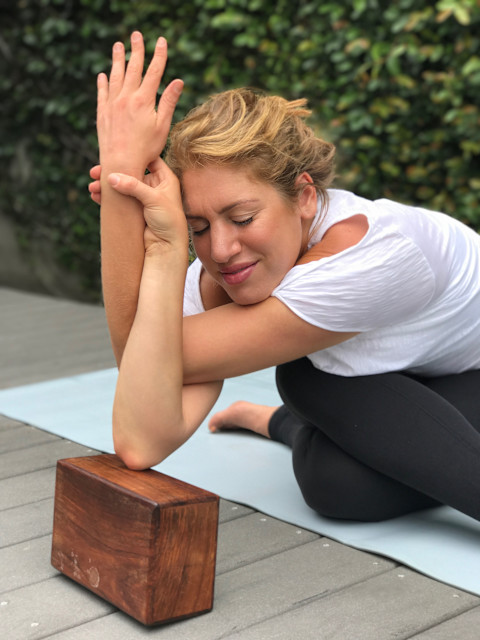
Cross your right leg over the left, stacking the right knee on top of the left, and bring the right foot to the outside of the left hip. Try to bring the heels equidistant from the hips: With the right leg on top, you'll have to gently move the right heel in closer to the left hip. Sit evenly on the sitting bones, using rolled-up blankets under your seat to support you.
Reach your arms out to the sides; left arm wraps under right; take a hold of the right wrist and lift the elbows out and up, finding a backbend on the inhale. On your exhale, hinge forward from your hips and rest the elbows on a yoga block as you extend your spine. Breathe deeply here for 5 breaths, then on a deep inhale, lift the arms up staying in the arm variation, swallow, and exhale. Release the arms, and switch which arm is wrapped on top. Repeat here, and repeat the sequence with the other knee on top.
This pose calibrates the thyroid and also increases blood supply to the legs and arms, making it a useful movement to counteract long periods of sitting in a chair or being hunched over your laptop. This is a great shoulder and back opener, which is great for improving range of motion.
2. Gomukhasana (cow-face pose) with twist.
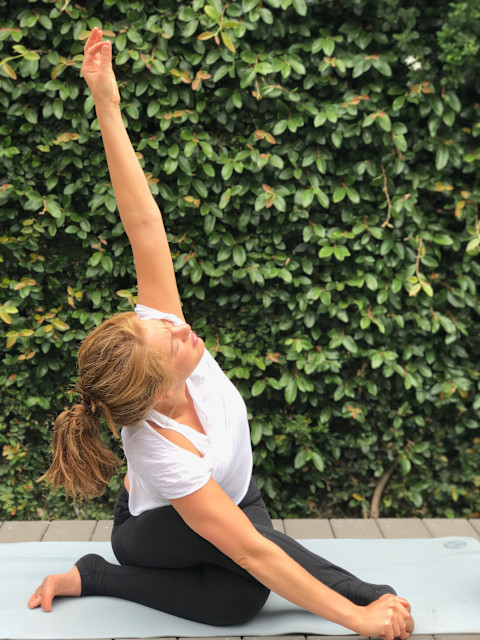
Start with the right leg crossed over the left, stacking the knees as described above. Hold on to the left foot (or ankle) with your left hand, twisting as you reach the right arm up, focusing your gaze on the right fingertips. The left forearm will be bent and pressed down to the earth around your left knee. Stay for five deep breaths, then twist to the opposite side and enjoy five deep breaths. Repeat the pose with the left knee on top, twisting first to the left, then to the right.
By equally lengthening and opening both sides of the body, this movement helps to correct posture and regain balance between the left and right sides of your body and the top and bottom. Twisting in this pose rinses the digestive organs; organizes and calms the mind; and reduces stress, anxiety, and fatigue.
3. Garudasana (eagle pose).
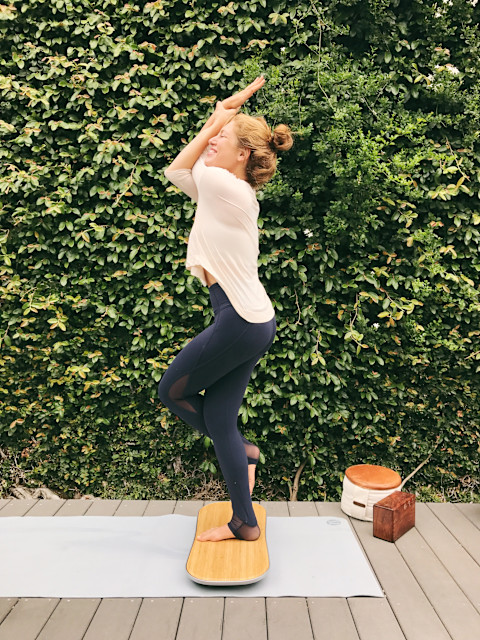
Stand in tadasana (mountain pose), with your hands on your hips. Bend your knees and sit your hips back slightly. Shift the balance to your right foot as you lift your left leg and cross it over your right thigh. Wrap your left foot around the back of your right calf. For more support and assistance, you can place your toes on the floor or a block beside your standing foot. Take a few breaths here to find your balance. Remember that balance is a dynamic process, so as you experience movements throughout the pose, smile and direct your drishti, or gaze, to a single point, which will help you to calm and focus your mind.
This pose stretches and broadens the area between the shoulder blades, releasing upper-back tension and opening the back of the heart. It also stretches your shoulders, ankles, hips, and wrists. And it broadens the sacrum, where tension and stress is often stored, and softens the groins, which allows a free flow of energy in the lower body.
4. Virabhadrasana III (warrior III pose).

From a high lunge with the right leg forward, reach your arms straight forward, shift your weight forward to balance on your front foot, and bring your arms, body, and back leg all in one line parallel to the ground, finding a slight backbend in your upper back. For an added benefit to calibrate and stimulate the thyroid, wrap your arms in eagle arms.
The right arm wraps under the left, elbows reach forward and slightly up, gaze is forward past your arms. Draw your navel inward toward your spine as you consciously square your hips and point your left toes downward, flexing your left toes and rolling the left thigh inward. Enjoy 5 breaths here, then gently step back into a lunge pose, unwrap the arms, and repeat on the other side.
5. Ustrasana (camel pose).

Camel is one of my favorite yoga poses to release stagnation around the thyroid and parathyroid glands. From a kneeling position, with knees hip-width apart, place your hands on your lower back at your sacrum, the bony plate at the base of your spine. Internally rotate your thighs, squeezing them toward each other, keeping your glutes relaxed. Inhale to engage your lower belly and reach your tailbone toward your knees, creating space between your lower vertebrae.
On another inhalation, lift your sternum and draw your elbows toward each other, allowing your rib cage to expand. Keep your sternum lifting, your core engaged, and your lower back open. Optionally, release your hands to your heels. Toes can remain tucked or untucked. Lift your shoulders to allow the trapezius muscles between the shoulder blades to rise up and cushion your cervical spine. Gently lower your head and neck and gaze at the tip of your nose. Take five breaths here, then bring your chin back toward your chest and your hands to your hips. Engage your lower abdomen and use your hands to support your lower back as you come back to sit upon your heels. For an added release, add in lion’s breath to this pose! As you exhale, open your mouth, stick out your tongue, and sigh as loud as you can. It feels SO good!
6. Setu bandhasana (bridge pose).
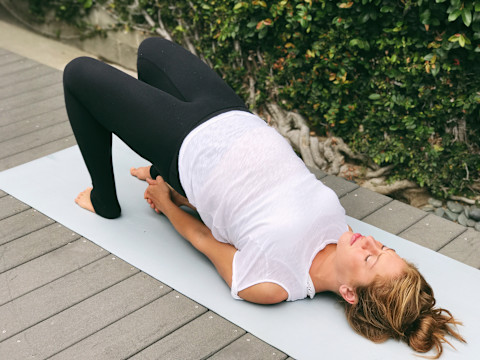
From a reclined position on your back, arms alongside your body, bend your knees and set your feet on the floor, hip-width apart, toes slightly pointing inward. On an exhalation, press your palms and feet actively as you lift your tailbone up toward the pubis. Keep your thighs and inner feet parallel. Clasp the hands into a fist below your pelvis and extend through the arms to help you stay on the tops of your shoulders, rolling your shoulder blades together underneath you. Lift your chin slightly away from the sternum while lifting the top of the sternum toward the chin. Enjoy 5 to 10 breaths here, then slowly release down to your back.
7. Urdhva dhanurasana (wheel pose).

Starting with the same foot placement as in bridge above, place your palms alongside your ears, fingertips pointing toward your shoulders. Pressing your inner feet and heels actively into the floor, exhale and push your tailbone up toward the pubis, lifting your hips. Activate and press down the inner hands into the floor and your shoulder blades against the back as you lift up onto the crown of your head. Extend the arms as you relax your head down and press your hips up. Enjoy 3 breaths here, and optionally repeat 2 more times.
8. Matsyendra virasana (fish pose with hero pose leg variation).
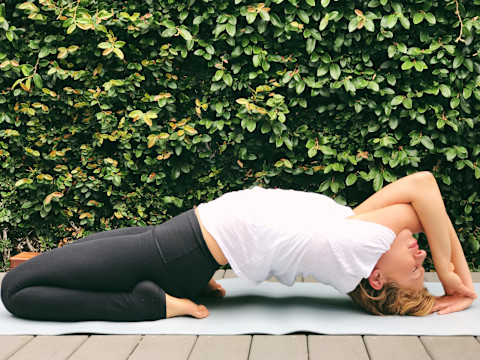
Join your knees and separate your shins as much as possible. Push your calf muscles to your sides with your hands and softly place your pelvis on the floor between your feet. Move your hands behind your back and slowly go on down to your elbows. For added support, place a block under the arch of your spine. Pushing down with your forearms, lift your chest, arch, and put the crown of your head on the floor.
Next, wrap your arms in the eagle arm variation described above. This pose increases flexibility in the knees and hips, tones the muscles in the arches of the feet, and increases circulation in the feet and legs. If having your legs in hero pose variation is not working for you, extend your legs out in front of you. Enjoy 10 deep breaths here as you breathe into the space around your throat and lungs. This is a great pose for relieving congestion, brain fog, mental fatigue, and anxiety.
9. Headstand.
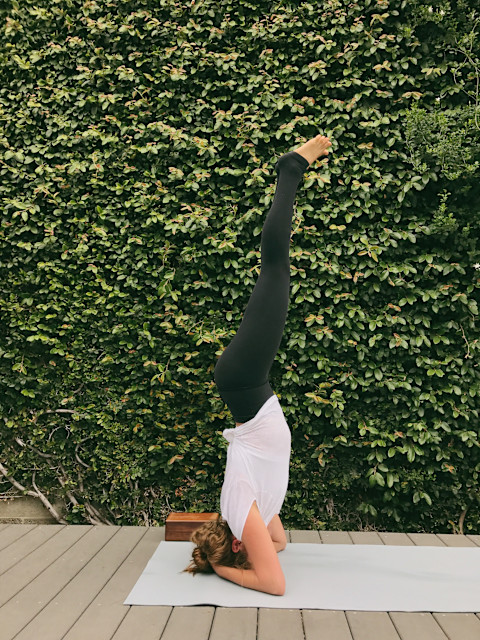
Begin in child’s pose, then tuck your toes. On an exhalation, bring your feet up, keeping your knees bent near your chest. Slowly extend your legs up together, as you press your forearms and wrists into the floor, lift your shoulders, and draw your mid-thoracic spine in and up. Stretch your legs fully up toward the ceiling by squeezing the outer thighs, calves, and ankles in toward one another and drawing the entire inner and back legs upward.
The stretch of the legs is crucial: It not only helps lift the pelvis and prevent the sacrum from sinking into the lower back but also helps lengthen the neck. Extend through the inner heels and inner balls of the feet so that the inner shins and calves stretch as much as the outer, and broaden the balls of your feet from the big to the little toe side. Relax your breath, soften your facial muscles, and allow your eyes to recede slightly into their sockets. Eventually your arms bear very little weight, serving merely as outriggers to maintain balance, and the pose feels light and nearly effortless. Slowly and lightly come down into child’s pose.
10. Child’s pose.
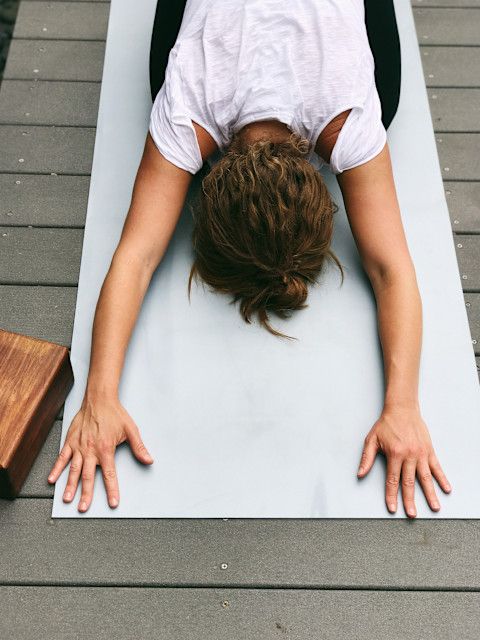
Rest in child’s pose with knees spread as wide as your yoga mat and your forehead pressing down to the earth. I love to rest a cushion or yoga block under my chest and forehead for extra support, and for tight hips, a rolled-up cushion or blanket between your seat and heels will feel really nice, too.
Take at least 10 breaths here, then find a comfortable seat for a grounding meditation.
Want to go deeper? You can take Fern's class on yoga for thyroid support here!

